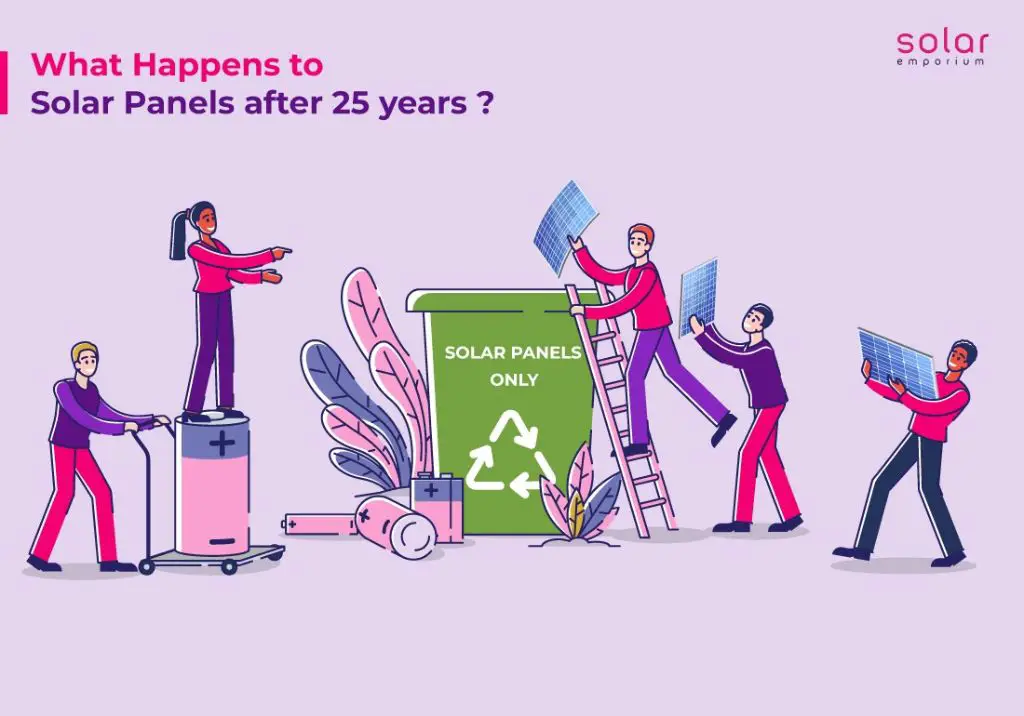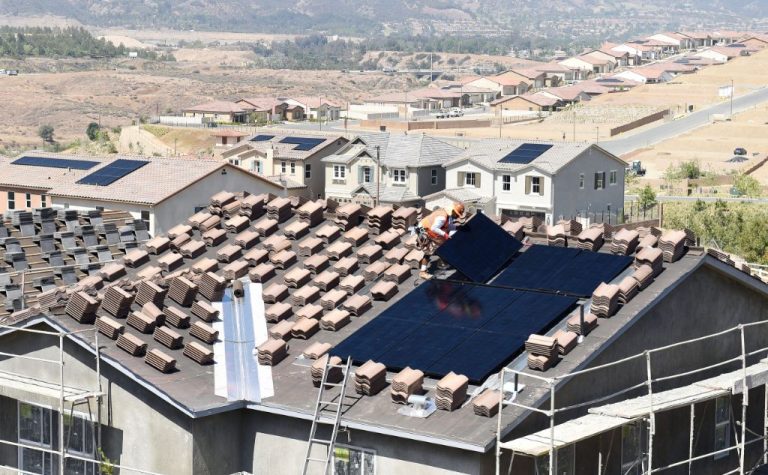What Happens To Solar Panels After 25 Years?

Solar panels have become an increasingly popular source of renewable energy over the past few decades. This has led homeowners, businesses and utilities to invest in solar panel systems to reduce their environmental impact and electricity bills. An important consideration when installing solar panels is determining their expected lifespan and performance over time. This will help determine the return on investment and long-term viability of a solar system.
This article provides an overview of what happens to solar panels after 25 years, which is the typical warranty period provided by most manufacturers. Key topics covered include solar panel lifespan, performance degradation over time, options for recycling panels at end-of-life, associated costs, and the environmental impacts. Understanding the lifespan and sustainability of solar panels is important for those considering investing in this technology.
Typical Lifespan
Most solar panels come with a performance warranty that guarantees a certain level of energy output for 25-30 years. Typically solar panels last for 30-35 years before degrading to 70-80% of their original power output. Some newer models using high efficiency monocrystalline cells last even longer. Companies like Komaes Solar, JinkoSolar, QCells, and SunPower offer 30-35 year warranties.[1] [2]
While most panels operate reliably for 25-30+ years, external factors like weather, climate, and installation methods can impact lifespan. Extreme weather like hailstorms, hurricanes, and hot temperatures contribute to wear and tear. Proper installation methods that allow air flow and avoid pooled water also promote longevity.
Regular cleaning and maintenance helps maximize the lifespan of a solar panel system. Monitoring panel output and performance over time can identify issues early. With proper care, modern solar panels often outlast their warranties and continue producing energy for 30+ years.
Performance Over Time
Solar panels lose some of their power output capacity over time, referred to as degradation. Most solar panels come with a 25-30 year performance warranty, meaning they’re guaranteed to maintain at least 80% of their original capacity after 25 years of use. However, solar panels typically last longer than their warranty period.
The rate that solar panels lose performance is called their degradation rate. The average degradation rate is around 0.5% to 1% per year, though high-quality panels may have rates as low as 0.2% to 0.3% per year. This means that after 25 years, a typical solar panel would produce around 80% to 87% of its original capacity. Factors that impact degradation include panel materials, manufacturing quality, climate conditions like temperature and humidity, and physical damage.
While performance declines over decades, studies show solar panels can still produce significant amounts of energy past their warranty period. For example, a 30-year NREL study on solar panels found that after 35 years they maintained around 80% performance. With an expected life of at least 30 years, solar panels remain productive assets for decades. Regular maintenance and cleaning can help further minimize loss of performance over their lifetime.
Sources:
https://ratedpower.com/blog/solar-panels-degradation/
https://www.solarreviews.com/blog/how-long-do-solar-panels-last
https://roofit.solar/why-do-solar-panels-degrade/
Recycling Solar Panels
Recycling solar panels at the end of their usable life has become a growing priority as more panels reach 20-30 years old. Recovering valuable materials through recycling helps reduce environmental impact and saves on costs of new manufacturing (Technology Review, 2022). There are a few main ways that used solar panels can be recycled:
Mechanical recycling uses shredding, hammering, and crushing to break down the solar panels. The glass, silicon, and metals can be recovered for reuse in new solar panels or other applications (Greenmatch, 2023). This is one of the most common and cost-effective recycling methods.
Thermal and chemical recycling use high heat or solvents to separate the components. This allows recovery of high purity materials but has higher costs than mechanical recycling (Technology Review, 2022).
Recycling makes use of valuable materials in used solar panels like silicon, silver, and glass. It reduces the need for new resource extraction and manufacturing. Recycling systems are still being developed but have strong economic and environmental benefits as demand grows.
Reuse
Reusing and reselling old solar panels is an attractive option for many homeowners and businesses looking to cut costs. Most solar panels come with a 25 year power warranty, meaning they are guaranteed to produce at least 80% of their original rated power after 25 years of use [1]. This makes used panels a viable option for powering homes and businesses on a budget.
Used solar panels can often be purchased for a fraction of the cost of brand new panels. However, there are some risks associated with buying used. Performance degradation, damaged panels, and lack of warranty coverage are all factors to consider [2]. Careful inspection and testing is recommended before purchasing used solar panels.
For those looking to get rid of their used solar panels, selling them is an option. Websites like Craigslist allow homeowners to post used solar panels for sale locally. There are also some solar companies that will buy back used panels. Though selling individual panels typically won’t yield a high dollar amount, every bit recovered helps offset recycling and disposal costs down the road [1].
Remanufacturing
Remanufacturing involves disassembling solar panels and reusing functional components to create new panels, reducing the need for raw materials. According to Ontility, one company developing proprietary remanufacturing equipment, solar panels can be “completely disassembled into commodity materials, components, and wafers.” The wafers, which make up the key photovoltaic material, can be reclaimed and used in new solar panels. Other components like the aluminum framing may also be salvaged and reused.
The remanufacturing process aims to extend the usable lifespan of solar panels by restoring old panels to like-new condition. According to Energy5, remanufactured panels can function for an additional 10-15 years. Remanufacturing solar panels conserves resources, reduces waste, and lowers costs compared to creating brand new panels.
Disposal
When solar panels reach the end of their usable lifespan, responsible disposal is crucial to prevent toxic materials from contaminating the environment. Solar panels contain hazardous materials like lead and cadmium that can leach into the soil and water if not properly handled.
There are a few recommended methods for solar panel disposal:1
- Recycling – Solar panels can be recycled to recover materials like glass, aluminum and semiconductors for reuse.
- Remanufacturing – Old solar panels may be refurbished by replacing damaged parts and re-assembling into new panels.
- Landfills – Solar panels can be safely disposed of in specialized landfills designed to contain toxic materials.
When disposing of solar panels, it’s important to go through reputable recycling companies or take them to designated waste facilities. Never try to dispose of solar panels through general municipal trash or waste streams.
With proper handling, the hazardous materials in solar panels will not get released into the environment. Following responsible disposal methods is crucial as solar adoption increases worldwide.
Costs
Recycling solar panels comes at a cost. According to one source, “There is a real gap between the cost to recycle solar panels and the value of the materials that you’re deriving from that process. It’s not economically feasible with today’s technologies” (Mass.gov). Solar panel recycling costs vary depending on the size and type of solar panels and the quantity being recycled, but on average it costs between $10-20 per panel (SolarAnswered). This can add up quickly if disposing of an entire solar system. The high costs are due to the labor, transportation, and special equipment needed to safely recycle solar panels. Some companies are working on ways to drive down recycling costs through economies of scale and improving recycling technologies. But for now, the costs exceed the value recovered from reclaiming the raw materials.
If solar panels are sent to a landfill instead, typical tipping fees apply which are lower than recycling costs. However, that passes the responsibility and environmental impact on to future generations. Some solar companies are starting to include the cost of eventual recycling into the upfront purchase price of solar panels to help incentivize proper disposal.
Environmental Impact
As solar panels become more mainstream, one concern is the environmental impact of disposing of them after their roughly 25-year lifespan. Solar panels contain hazardous materials like lead and cadmium that can leach into the environment if not properly recycled (End-of-Life Solar Panels: Regulations and Management – EPA). According to the EPA, solar panel disposal is largely unregulated at the federal level. Some states, like California, require recycling under e-waste laws.
Solar panel recycling is an emerging industry working to address the coming influx of end-of-life panels. Recycling recovers around 90% of materials for reuse, while sending panels to landfills can leach toxic materials. However, recycling costs $20-30 per panel while landfill disposal is just $1-2 (The Dark Side of Solar Power – Harvard Business Review). Making solar panel recycling affordable and accessible is key to managing the solar waste stream responsibly.
Overall, while used solar panels present disposal challenges, the environmental benefits of renewable solar energy far outweigh end-of-life impacts. Continued solar panel innovation and recycling improvements can further reduce the industry’s footprint. With proper end-of-life management, solar power represents a sustainable energy source for the future.
Conclusion
In summary, solar panels typically have a lifespan of around 25 years, though their performance and efficiency slowly declines over time. While older panels can often continue generating some electricity past their warranty period, recycling and reusing panels is an attractive option to recover valuable materials and reduce waste.
Recycling processes allow recovery of glass, aluminum, copper and silicon from panels at end of life. Reuse and remanufacturing solar panels into new products is also gaining traction as an eco-friendly solution. Proper disposal is critical to minimize environmental hazards from panels in landfills.
Looking ahead, capacity for solar panel recycling and reuse will need to expand to handle the growing volume of end-of-life panels. With the right processes in place, the solar industry can work towards a circular economy and sustainable practices for the future.





